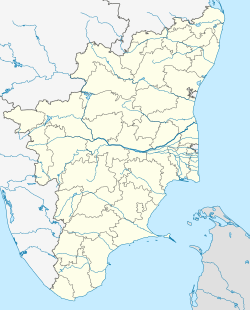Perur
Perur பேரூர் | |
|---|---|
Neighbourhood | |
 Vimahana of Patteeshwarar temple | |
 Perur Location in Tamil Nadu, India | |
| Coordinates: 10°58′N 76°54′E / 10.97°N 76.9°E / 10.97; 76.9Coordinates: 10°58′N 76°54′E / 10.97°N 76.9°E / 10.97; 76.9 | |
| Country | |
| State | Tamil Nadu |
| District | Coimbatore |
| Elevation |
418 m (1,371 ft) |
| Population (2001) | |
| • Total | 7,937 |
| Languages | |
| • Official | Tamil |
| Time zone | UTC+5:30 (IST) |
| Vehicle registration | TN-99 |
Perur is a neighbourhood located on western side of Coimbatore in the Indian state of Tamil Nadu.It has famous Siva Temple, Patteeswarar.
Contents
1 Geography
2 Etymology
3 Demographics
4 Politics
5 Religious importance
6 References
Geography
Perur is situated about 7 km from Coimbatore City Railway station and 25 km from Coimbatore Airport. The area is mostly agricultural. Predominantly Cash crops like coconut, banana are grown in Perur .
Etymology
According to the Tamil Nadu, Senthandivakaram any place which has more than 500 families will be considered as Perur.[1] So in ancient times this must be a fertile land and populated area.
Demographics
As of 2001[update] India census,[2] Perur had a population of 7937. Males constitute 50% of the population and females 50%. Perur has an average literacy rate of 69%, higher than the national average of 59.5%: male literacy is 76%, and female literacy is 61%. In Perur, 10% of the population is under 6 years of age.
Politics
Perur assembly constituency is part of Coimbatore (Lok Sabha constituency).[3]
Religious importance
Perur is very famous for its very old Perur Pateeswarar Temple. The temple was built by Karikala cholan.[4] Other than this temple there are numerous other temples and many wedding halls. Just 500 m away from the main temple is the bank of Noyyal river. People arrive here round the year to perform the rituals of deceased people
References
^ V. VEDACHALAM (20 July 2011). "Jain monastery at Kazhugumalai". The Hindu. Retrieved 29 August 2012..mw-parser-output cite.citation{font-style:inherit}.mw-parser-output .citation q{quotes:"""""""'""'"}.mw-parser-output .citation .cs1-lock-free a{background:url("//upload.wikimedia.org/wikipedia/commons/thumb/6/65/Lock-green.svg/9px-Lock-green.svg.png")no-repeat;background-position:right .1em center}.mw-parser-output .citation .cs1-lock-limited a,.mw-parser-output .citation .cs1-lock-registration a{background:url("//upload.wikimedia.org/wikipedia/commons/thumb/d/d6/Lock-gray-alt-2.svg/9px-Lock-gray-alt-2.svg.png")no-repeat;background-position:right .1em center}.mw-parser-output .citation .cs1-lock-subscription a{background:url("//upload.wikimedia.org/wikipedia/commons/thumb/a/aa/Lock-red-alt-2.svg/9px-Lock-red-alt-2.svg.png")no-repeat;background-position:right .1em center}.mw-parser-output .cs1-subscription,.mw-parser-output .cs1-registration{color:#555}.mw-parser-output .cs1-subscription span,.mw-parser-output .cs1-registration span{border-bottom:1px dotted;cursor:help}.mw-parser-output .cs1-ws-icon a{background:url("//upload.wikimedia.org/wikipedia/commons/thumb/4/4c/Wikisource-logo.svg/12px-Wikisource-logo.svg.png")no-repeat;background-position:right .1em center}.mw-parser-output code.cs1-code{color:inherit;background:inherit;border:inherit;padding:inherit}.mw-parser-output .cs1-hidden-error{display:none;font-size:100%}.mw-parser-output .cs1-visible-error{font-size:100%}.mw-parser-output .cs1-maint{display:none;color:#33aa33;margin-left:0.3em}.mw-parser-output .cs1-subscription,.mw-parser-output .cs1-registration,.mw-parser-output .cs1-format{font-size:95%}.mw-parser-output .cs1-kern-left,.mw-parser-output .cs1-kern-wl-left{padding-left:0.2em}.mw-parser-output .cs1-kern-right,.mw-parser-output .cs1-kern-wl-right{padding-right:0.2em}
^ "Census of India 2001: Data from the 2001 Census, including cities, villages and towns (Provisional)". Census Commission of India. Archived from the original on 2004-06-16. Retrieved 2008-11-01.
^ "List of Parliamentary and Assembly Constituencies" (PDF). Tamil Nadu. Election Commission of India. Archived from the original (PDF) on 4 May 2006. Retrieved 11 October 2008.
^ "History of Perur Patteeswarar temple". Retrieved 15 October 2011.
This Coimbatore district location article is a stub. You can help Wikipedia by expanding it. |

Comments
Post a Comment